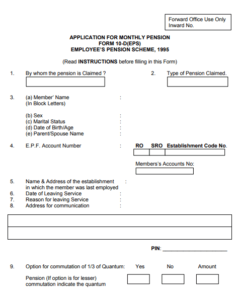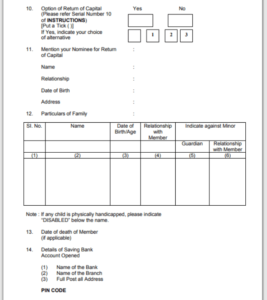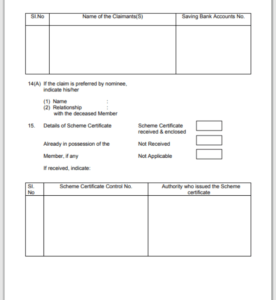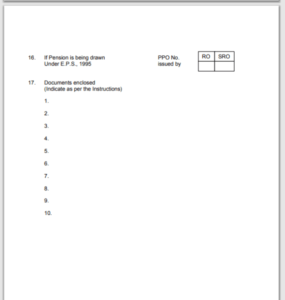The first thing that one should know about the EPS is eligibility criteria. An employee is eligible to get monthly pension benefits once he/she reaches the age of 58. But, there is another condition too. The employee must have completed 10 years of service in the company. Only after fulfilling these 2 criteria, an employee can receive a monthly pension. Here, we are going to talk about how Form 10D is useful for getting a monthly pension.
The Form 10D is usually used by the person who wants to claim for the pension after his/her retirement. Other than that, the Form 10D is also used to claim for family pension, child pension, orphan pension, or nominee pension, in case the member dies. But before doing that, we will have a brief discussion about the EPS scheme and its various aspects.
The Employee’s Pension Scheme came into action on 16Th November 1995. It replaced the Family Pension Scheme of 1971 and made new rules. The member of the EPF Act becomes a member of the EPS Act and is eligible to avail of the pension benefits as per this act. The new EPS Act has changed the entire description of pension benefits by making new rules. There are even new features in the EPS.
Some of the major aspects of the new EPS scheme are contribution, withdrawal, and transfer of EPS. Each of these sections is discussed later in the article below.
Download The Form 10D
In this article
You can download the Form 10D from https://www.epfindia.gov.in/site_docs/PDFs/Downloads_PDFs/Form10D.pdf
Filling Form 10D To Claim Pension From EPS Act
The form 10D is for getting monthly pension benefits. This form is used to claim the monthly pension and one needs to fill it properly. There are certain steps that you need to follow, which would help you in filling out the form 10D. The form 10D will help you in claiming your monthly pension benefits.
This form is useful for people who have retired recently. Below are the steps which you need to follow closely for the filling procedure of the form. There are certain blank spaces in the form which you need to follow. Here we would tell you about each section and what you should write in the box for claiming your pension.

1. By Whom Is Pension Claimed?
The first blank space or question you need to answer in the form is, “By whom is pension claimed?” Below are the various options from which you need to select the most suitable one.
- Member: This option is for the people who are contributing towards the EPF and EPS. If you are a member of the EPF as well as the EPS account, then select this option.
- Widow/Widower: If you are the spouse of the deceased EPF/EPS member, then you have to fill widow/widower here
- Major: If you are the child of the deceased employee and have attained the age of 18, then select the “Major” option.
- Orphan: If the member of the EPF/EPS is dead and has no spouse to guide his/her child, then the child has to select this option.
- Guardian: If the eldest child, less than 18 years, of the family, is contributing towards the EPS/EPF.
- Nominee: The person whom the member has mentioned in his/her EPF documents.
- Dependent parent: This option is for parents of the deceased employee.
2. Type Of Pension Claimed
The next point is the type of pension that the person wants to claim. Below are the various types of pension schemes, from which you need to select the most suitable one.
- Superannuation pension: This is the type of pension that a member can get on attaining the age of 58. In this type of pension, the employee will get a pension once he/she reaches the age of 58. Here, it does not matter whether the person is in service or not.
- Disablement pension: This type of pension is for disabled employees who cannot work. They can get a lifetime of pension, but they have to go through a medical examinations first.
- Reduced pension: This is the type of pension made for employees who want to leave the company after the age of 50. Here, the least age for getting a reduced pension is 50, and the largest age is 58.
- Widow & children pension: This type of pension is for the family of the deceased employee. The widow/widower and the child can get a pension under this scheme.
- Orphan pension: if the employee dies and has a child with no other guardian, then the child can get a pension. Here, the child is eligible to get a pension until he/she reaches the age of 25. If the spouse of the deceased employee marries again, then the child is known as an “orphan” by the EPFO. In this case, the child can claim a pension under this category.
- Nominee pension: In this type of pension, the nominee is eligible to get the nominee pension. The nominee is usually a family member of the employee. But, if the employee has no family member, then he/she can nominate anyone with the help of form 2(R).
- Dependent parent: This pension scheme is for the parents of the deceased employee. If the employee had no spouse or children and had not nominated anyone, then the parents will get a pension.
3. Details
In this section, you have to provide your details. What are the details? Below is the list of things that you have to provide in this section.
- Name of the claimant in BLOCK LETTERS
- Marital status of the claimant. There will be an option like Widow/widower/divorces/unmarried/married.
- Date of birth of the claimant in the format: dd/mm/yyyy.
- Name of the father and name of husband (if the claimant is a married female). Write the names in BLOCK LETTERS.
4. EPF Account Number
The next section is filling out the EPF account number. The account number for the EPF has a Region code, office code, the code number, and the account number. It might also include an extension sub-code if there is any. The region code is different for different regions. You can find them easily on the official website of EPFO. Go to the website www.epfindia.gov.in and then click on the “Establishment Search” option. Here, you can get your region code by typing your establishment name.
5. Name & Address Of The Establishment
In this section, you have to fill out the name and the establishment in which you are working. If you are claiming as the child/spouse/parents of the deceased employee, then you have to type the name and address of the organization where the employee used to work.
6. Date Of Leaving Service
Here, you have to mention the correct leaving date of the employee in the dd/mm/yyyy format. If the employee has reached 58 years and is still working, select the “still in service” option.
7. Reason For Leaving Service
In this section, you have to mention the reason as to why the employee left the organization. The employee can get a lifetime of a pension if the reason is permanent disablement. In other cases, the person has to state the actual reason for leaving the service.
8. Address Of Communication
In this section, provide your present address in the form. All the documents and communication will be done in this address.
8A. In Case Of Reduced Pension
If the employee has left the service before reaching the age of 58, then he/she is eligible to get a reduced pension. Here, the employee has to mention the date from which he/she wants to get a pension. Keep in mind that the employee should be above the age of 50 to avail of this benefit. If the person has not reached 50 years, then he/she is not eligible for a reduced pension.
9, 10, 11. Commutation & Return Of Capital In EPS Pension Form Number 10D
The EPFO removed “commutation and return of capital on the superannuation” pension. It removed this part from form 10D, from 26th September 2008. The term commutation means that a retiring employee can get 30% of his/her pension amount in advance. After withdrawing the advance, the employee will get a monthly pension too. The employee will get this monthly pension from the remaining pension amount. Here, the commutation scheme is 1/3rd of the original pension amount.
The term “return of capital on superannuation” states that the employee can withdraw the entire pension amount. Here, the retiring employee cannot get any monthly pension if he/she withdraws the amount in one go. These two options are not applicable if the pension start date is after 26Th September 2008. The government took this decision due to various reasons. One of which is to help the employee after retirement.

12. Family Details In EPS Pension Form Number 10D
The whole point, number 12 is dedicated to family member details. If the employee dies, then his/her family is entitled to receive a lifelong pension. In this section, the person has to mention the list of family members who are alive.
If the employee is dead, then the spouse or kid has to fill out this section. They have to provide the name of the immediate family members who are still alive. Besides that, you also have to state the relationship with each family member in the form. If there is any guardian, then you should also include the guardian’s name. Moreover, if the child is going to receive the pension, then he/she has to provide the birth certificate too. Other than that, you even have to give ESI records, age proof, and other necessary documents too. If there is a guardian, then you have to provide the Guardianship certificate too.
13. Date of death of a member (if applicable)
If the EPF member is not alive, then you have to fill out this section as well. Mention the date of death of the member and attach a copy of the death certificate along with the form.

14, 15. Bank Details For EPS Pension
In this section, you have to state the bank details in the form. The EPFO will send the pension through the bank account of the employee. It is advisable to open savings bank accounts in certain banks if you want to avail the pension benefits. The employee, spouse, and the children all should have savings account in the same branch. If the child is eligible to receive a child pension, then he/she should have an account.
In this section, mention the bank account number in the space. Also, make sure that the accounts are in any one of the banks which are mentioned in the list of distributing banks.
14A Nomination Details & Scheme Certificates
If the employee is dead and has no immediate family members, then the nominee is eligible to get the pension. Usually, the nominee is a family member, but in certain cases, the nominee is not a family member. If the employee does not have any immediate family member, then he/she can nominate anyone as the nominee.
In the case of EPS, the nominee is the same as that in EPF. Here, the nominee can claim for pension benefits. If there is no nominee, and the employee has parents, then they can claim for the pension benefits. Another thing to keep in mind is that, if a person has worked for less than 10 years, then he/she is eligible for withdrawing or transferring the money of the pension account. For transferring the money, the employee needs a “Scheme Certificate.” If the employee has a scheme certificate, then he/she has to mention the details of the scheme certificate in the form. The details include the scheme certificate control number and the name of the authority who was responsible for issuing the certificate.

16. Pension Drawn Under EPS 1995
If the employee is already receiving a pension under the EPS Act of 1995, then he/she has to provide the details in this section.
17. Documents Which Should Be Attached Along With The Form
There are certain documents which you need to attach along with the form 10D for verification and proof. Here is the list of all the documents.
- The thumb impression of the pensioner (duplicate) and his/her descriptive role.
- Photographs of the pensioner which should be attested by the employer. Make sure that the employer mentioned the PF account number and name of the person in the photograph.
- If the claimant of the pension is the widow/widower, then he/she has to provide his/her photograph. If the employee had any child, a photograph of the child is also necessary.
- If the employee is unfit or disabled, then he/she should have a medical examination, as stated by the EPF office. The pensioner will get a lifetime pension if he/she suffers from disablement.
- A cancelled cheque of the employee which should have the bank account number in it.
Employer’s Approval In EPS Pension Form Number 10D
Another section of the form 10D is the employer’s approval section. After you have filled out the form send it to the organisation in which you have the last s=worked. In the organisation, the employer will check the form and then fill out the employer’s section and then sign it. After it has been done, the employer will send the form to the EPFO office, and the pension process will start.

Contribution, Transfer, And Withdrawal Of EPS
The three aspects are discussed here:
Contribution Towards EPS Account
As per the new EPS rule, only the employer can contribute towards the EPS account. It is well known that the employer contributes 12% of his/her monthly salary towards the EPF. Out of this 12%, 8.33% goes towards the EPS account. The remaining amount goes towards the EPF account. When the employee reaches the age of 58, he/she no longer remain a member of EPF.
As per the new rules stated on April 25, 2016, an employee can defer the pension amount up to 60 years. There does not need to be any contribution during the deferred period. If an employee defers the pension amount, then he/she will get a hike of 4% for every deferred year in the pension.
Withdrawal From EPS Account
If you have worked for more than 10 years, then you cannot withdraw money from your EPS account. An employee who has worked for less than 10 years, is eligible for EPS withdrawal or he can withdraw money from the EPS account. But, the employee should have worked for a minimum of 180 days to withdraw money. A person can withdraw money by using Form 10C. A person can withdraw the money from the EPS account, but he/she should remember that amount is taxable.
As per the rules, a person who has worked for more than 10 years in a government organization, can only avail for the monthly pension benefit. Here, the employee cannot withdraw money from the EPS account. When can a person withdraw money from the EPS account? An employee can only withdraw money from the EPS account if he/she has worked for a minimum of 180 days and a maximum of 10 years in the organization.
If an employee wants to withdraw money from the EPS account, before or after the mentioned time period, he/she won’t be able to do so. Moreover, the money that is withdrawn from the EPS account is liable for taxation.
Transfer Of EPS Amount
If an employee is changing jobs, then he/she can either withdraw or transfer the amount. If you wish to transfer the EPS amount to a new account, then you can do so by using the Scheme Certificate. You have to fill out the form 10C for issuing a Scheme Certificate. Submit the Scheme certificate to the new employer and then fill out form 13. After filling out the form, you can transfer the amount from the old EPS account to a new one.
Frequently Asked Questions
1. What is the use of form number 10D?
The form 10D is used for claiming the monthly pension benefits. If you wish to claim your pension benefits, then you can use the form 10D for doing this. Moreover, if you have worked for more than 10 years in an organisation, then you have to fill out this particular form for claiming pension benefits.
2. How to fill out the family section in the form 10D?
You have to state the names of all the living immediate family members. Along with that, you have to mention the relationship of the members with the employee.
3. I have filled out the form 10D. What should I do next?
After you have filled out the form 10D, you have to send the form to the last organisation in which you have worked. The employer will approve the form and then pass it to the EPFO office. If the employee has died, then the claimant (spouse/children/parents/nominee) has to send the form to the organisation in which the member has last worked.
4. How many photographs do I have to provide with the form?
You have to provide 3 photographs of yourself along with the form. The employer has to attest the photographs in the form.
5. I have worked for less than 10 years in a company. Can I withdraw money from the EPS account?
If you have worked for less than 10 years, you can withdraw from the account or transfer the amount to your new account. But, if you have worked for more than 10 years, then you cannot withdraw money from the EPS account.
The employees who have reached the age of 58 and have worked for more than 10 years have to use form 10D. This particular form will help the person in claiming the pension benefits. The form 10D can even be used by the child or spouse of the employee if the employee dies. In this case, the child and the spouse can get pension benefits. The form 10D has different sections for such cases and will further help the spouse or child is getting the pension benefits of the deceased employee.

Sir, Referring to the section frequently asked question:
For the Attestation of my photographs 3nos by the employer, where should I paste the photos in the form 10D. Whether company seal is also required over the photograph? Is my Aadhar copy required to be enclosed with above application. Please reply. Regards, Vijayakumar